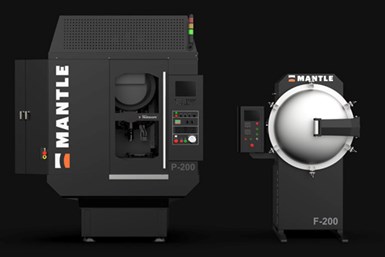Mantle Metal 3D Printing System for Toolmaking, Prototypes
The technology is designed for easy installation and use so that, with minimal training, manufacturers can have users quickly operating and running the machine.
Share
Read Next

Mantle P-200 printer and F-200 furnace. Photo Credit: Mantle
Mantle’s P-200 printer and F-200 furnace metal 3D printing technology for toolmaking are said to simplify the way mold tool components are made and accelerate how manufacturers make molded parts, speeding the process of going from product idea to launch.
According to the company, the technology reduces the time it takes to create tooling components because it eliminates or reduces many operations which have been traditionally required to make precise, durable steel tool components.
The technology is designed for ease of installation and use. It is said the technology is intuitive so that, with minimal training, manufacturers can have users quickly operating and running the machine.
Mantle’s system and TrueShape technology includes the P-200 printer, which is a hybrid system built on a CNC platform that integrates printing and machining to produce parts with the accuracy and surface finish required for tooling. The P-200 printer has a build volume of 200 × 200 × 150 mm. The F-200 furnace sinters parts from the printer and produces tooling components that are said to be both durable and accurate. One furnace can sinter multiple parts and support multiple printers.
The technology also includes two tool steel materials, H13 and P2X (a steel comparable to P20) which the company says are durable, stable and perform like traditional tool steels with secondary operations such as machining, polishing, coating and laser welding. The system also features easy-to-use software that automates the printing process, including the generation of all tool paths and machine instructions, the company says.
Deliveries of the first production systems are planned for the first half of 2023.
Related Content
-
The Connector Conundrum: 3D Printed Mold Tooling’s Role in Innovation
ReelView Fishing faced an electronics obstacle in the development of its new technology for underwater video. Additive manufacturing for moldmaking allowed for the speed necessary to iterate to a solution. How inventors and invention will benefit from new ways of obtaining production-ready tooling.
-
When Advocacy Leads to Adoption: How Pella Applies (and Manages) AM Capacity
The window and door maker offers a picture of successful, widespread 3D printing adoption across the different needs of a manufacturing organization. The outreach and education effort worked. Now, here is the next phase.
-
How AM Enables Cobot Automation for Thyssenkrupp Bilstein (Includes Video)
The shock absorber maker has responded to its staffing shortages through extensive use of collaborative robots. In-house 3D printing makes this possible by providing the related hardware needed to complete the cobot-automated cells.














